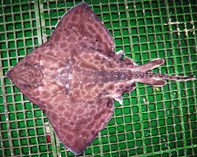Add your observation in Fish Watcher
| Native range | All suitable habitat | Point map | Year 2050 |

|
| This map was computer-generated and has not yet been reviewed. |
| Amblyraja georgiana AquaMaps Data sources: GBIF OBIS |
Upload your photos and videos
Pictures | Google imageAmblyraja georgiana
Picture by Reyes, P.
Pictures | Google imageAmblyraja georgiana
Picture by Reyes, P.
Common names from other countries
Classification / Names Κοινά ονόματα | Συνώνυμα | Catalog of Fishes(Γένος, Είδη) | ITIS | CoL | WoRMS | Cloffa
Ελασμοβράγχιοι (καρχαρίες και σαλάχια) (sharks and rays) > Rajiformes (Skates and rays) > Rajidae (Skates)
Etymology: Amblyraja: Greek, amblys = darkness + Latin, raja, -ae = ray (Raja sp.) (Ref. 45335).
Eponymy: This is a toponym referring to the fact that the holotype was caught in the coastal waters of South Georgia and was named after that island. (Ref. 128868), visit book page.
More on author: Norman.
Etymology: Amblyraja: Greek, amblys = darkness + Latin, raja, -ae = ray (Raja sp.) (Ref. 45335).
Eponymy: This is a toponym referring to the fact that the holotype was caught in the coastal waters of South Georgia and was named after that island. (Ref. 128868), visit book page.
More on author: Norman.
Environment: milieu / climate zone / depth range / distribution range Οικολογία
Θαλασσινό(ά) βαθύβιο(ς); εύρος βάθους 20 - 350 m (Ref. 58839). Deep-water; 43°S - 74°S, 48°E - 23°W (Ref. 114953)
Κατανομή Χώρες | Περιοχές FAO | Οικοσυστήματα | Παρουσίες | Point map | Εισαγωγές | Faunafri
Southeast Pacific: Chile (Ref. 27540). Southern Ocean: around South Georgia Island and on the ridge westward towards Black Rocks. Occasionally seen on the Scotia Ridge.
Μέγεθος / Βάρος / Age
Found on continental and insular shelves, as well as upper slopes. Feeds mainly on small benthic invertebrates (Ref. 114953). Oviparous (Ref. 205). Reaches maturity at 80-90 cm TL; birth size at ca. 20 cm TL (Ref. 114953). Distinct pairing with embrace. Young may tend to follow large objects, such as their mother (Ref. 205). Eggs are oblong capsules with stiff pointed horns at the corners deposited in sandy or muddy flats (Ref. 205). Egg capsule measures 116.5 mm long and 80.0 mm wide (Ref. 41249). Utilized as fishmeal and possibly not utilized for human consumption due to extreme roughness of its squamation (Ref. 5159).
Life cycle and mating behavior Γεννητική Ωρίμανση | Αναπαραγωγή | Γεννοβολία | Αβγά | Γονιμότητα | Προνύμφες
Oviparous, paired eggs are laid. Embryos feed solely on yolk (Ref. 50449). Distinct pairing with embrace. Young may tend to follow large objects, such as their mother (Ref. 205). Eggs have horn-like projections on the shell (Ref. 205).
Main reference
Upload your references | Αναφορές | Συντονιστής : McEachran, John | Συνεργάτες
McEachran, J.D. and K.A. Dunn, 1998. Phylogenetic analysis of skates, a morphologically conservative clade of elasmobranchs (Chondrichthyes: Rajidae). Copeia 1998(2):271-290. (Ref. 27314)
IUCN Red List Status (Ref. 130435: Version 2024-2)
Data deficient (DD) ; Date assessed: 08 February 2019
Threat to humans
Harmless
Human uses
αλιεία: παραδοσιακή αλιεία
FAO(αλιεία: Παραγωγή; publication : search) | FishSource | Η θάλασσα γύρω μας
Περισσότερες πληροφορίες
Trophic ecology
Τροφικά αντικείμενα
Σύσταση δίαιτας
Κατανάλωση τροφής
Food rations
Θηρευτές
Τροφικά αντικείμενα
Σύσταση δίαιτας
Κατανάλωση τροφής
Food rations
Θηρευτές
Ecology
Οικολογία
Home ranges
Οικολογία
Home ranges
Population dynamics
Παράμετροι Αύξησης
Max. ages / sizes
Length-weight rel.
Length-length rel.
Length-frequencies
Mass conversion
Στρατολόγηση
Αφθονία
Παράμετροι Αύξησης
Max. ages / sizes
Length-weight rel.
Length-length rel.
Length-frequencies
Mass conversion
Στρατολόγηση
Αφθονία
Life cycle
Αναπαραγωγή
Γεννητική Ωρίμανση
Γονιμότητα
Γεννοβολία
Spawning aggregations
Αβγά
Egg development
Προνύμφες
Δυναμική προνυμφών
Αναπαραγωγή
Γεννητική Ωρίμανση
Γονιμότητα
Γεννοβολία
Spawning aggregations
Αβγά
Egg development
Προνύμφες
Δυναμική προνυμφών
Anatomy
Επιφάνεια βραγχίων
Brain
Otolith
Επιφάνεια βραγχίων
Brain
Otolith
Physiology
Body composition
Nutrients
Κατανάλωση οξυγόνου
Κολυμβητικός τύπος
Ταχύτητα κολύμβησης
Visual pigments
Fish sound
Diseases & Parasites
Toxicity (LC50s)
Body composition
Nutrients
Κατανάλωση οξυγόνου
Κολυμβητικός τύπος
Ταχύτητα κολύμβησης
Visual pigments
Fish sound
Diseases & Parasites
Toxicity (LC50s)
Genetics
Γενετική
Heterozygosity
Κληρονομικότητα
Γενετική
Heterozygosity
Κληρονομικότητα
Human related
Aquaculture systems
Προφίλ υδατοκαλλιεργειών
Στελέχοι
Ciguatera cases
Stamps, coins, misc.
Aquaculture systems
Προφίλ υδατοκαλλιεργειών
Στελέχοι
Ciguatera cases
Stamps, coins, misc.
Εργαλεία
E-book | Οδηγός πεδίου | Ανάλυση κατά μήκος συνθέσεων | Εργαλείο ιστορίας ζωής | Σημειακός χάρτης | Classification Tree
| Catch-MSY |
Special reports
Download XML
Διαδικτυακές πηγές
Aquatic Commons | BHL | Cloffa | Websites from users | Check FishWatcher | CISTI | Catalog of Fishes(Γένος, Είδη) | DiscoverLife | ECOTOX | Faunafri | Fishtrace | GenBank(genome, nucleotide) | GloBI | GOBASE | | Google Books | Google Scholar | Google | IGFA World Record | MitoFish | Otolith Atlas of Taiwan Fishes | PubMed | Reef Life Survey | Scirus | SeaLifeBase | Δέντρο Ζωής | Wikipedia(Go, αναζήτηση) | World Records Freshwater Fishing | Zoological Record
Estimates based on models
Preferred temperature (Ref. 115969): -1.4 - 0.5, mean -0.6 (based on 28 cells).
Phylogenetic diversity index (Ref. 82804): PD50 = 0.5010 [Uniqueness, from 0.5 = low to 2.0 = high].
Bayesian length-weight: a=0.00302 (0.00141 - 0.00645), b=3.24 (3.07 - 3.41), in cm Total Length, based on LWR estimates for this (Sub)family-body shape (Ref. 93245).
Τροφικό Επίπεδο (Ref. 69278): 4.2 ±0.3 se; based on size and trophs of closest relatives
Ελαστικότητα (Ref. 120179): Χαμηλό, ελάχιστος χρόνος για διπλασιασμό πληθυσμού 4,5 - 14 έτη (Assuming tm>5).
Fishing Vulnerability (Ref. 59153): High to very high vulnerability (69 of 100).
Climate Vulnerability (Ref. 125649): Moderate vulnerability (38 of 100).




